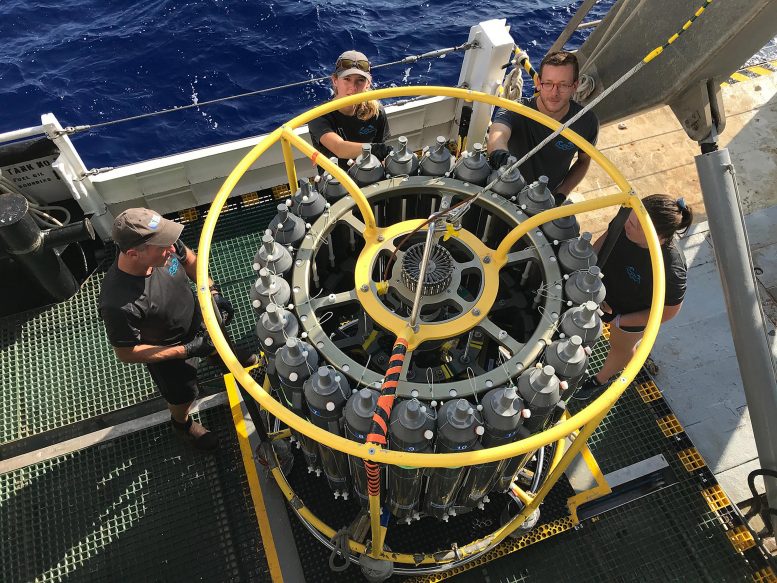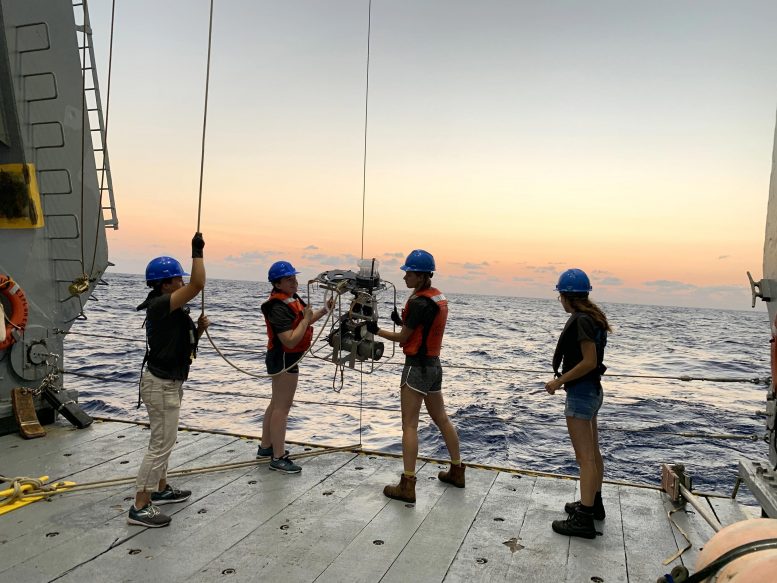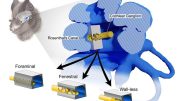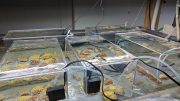
From L to R: Rod Johnson (BATS Co-PI), Emily Davey (Research Technician), Dom Smith (Research Technician) and Claire Medley (Research Technician) sample the CTD for dissolved O2 and CO2 aboard the R/V Atlantic Explorer during a routine Bermuda Atlantic Time-series Study (BATS) cruise. Credit: Ella Cedarhold, Bermuda Institute of Ocean Sciences
Two open-ocean hydrographic stations record 40 years of change in the subtropical North Atlantic Ocean.
New research published in Nature Communications Earth & Environment today (October 16, 2020) uses data from two sustained open-ocean hydrographic stations in the North Atlantic Ocean near Bermuda to demonstrate recent changes in ocean physics and chemistry since the 1980s. The study shows decadal variability and recent acceleration of surface warming, salinification, deoxygenation, and changes in carbon dioxide (CO2)-carbonate chemistry that drives ocean acidification.
The study utilized datasets from Hydrostation ‘S’ and the Bermuda Atlantic Time-series Study (BATS) projects at the Bermuda Institute of Ocean Sciences (BIOS). Both are led by Professor Nicholas Bates, BIOS senior scientist and the projects’ principal investigator (PI), and Rod Johnson, BIOS assistant scientist, and the projects’ co-PI. Together, these time-series represent the two longest continuous records of data from the global open ocean.
“The four decades of data from BATS and Hydrostation ‘S’ show that the ocean is not changing uniformly over time and that the ocean carbon sink is not stable over recent time with variability from decade to decade,” Bates said.

From L to R: Ella Cedarhold (Marine Technician), Claire Medley (Research Technician), Emily Davey (Research Technician), and Lydia Sgouros (Marine Techician) deploy an in-situ pump off the stern of the R/V Atlantic Explorer for proteomics sampling during a recent Bermuda Atlantic Time-series Study (BATS) cruise. Credit: Bermuda Institute of Ocean Sciences
Of the two sites, Hydrostation ‘S’ is the oldest, located approximately 15 miles (25 km) southeast of Bermuda and consisting of repeat biweekly hydrographic observations of temperature, salinity, and dissolved oxygen conducted through the water column since 1954. The Bermuda Atlantic Time-series Study (BATS) site is located approximately 50 miles (80 km) southeast of Bermuda. It consists of monthly sampling of the physics, chemistry, and biology of the entire water column since 1988. The study’s datasets represent more than 1381 cruises to Hydrostation ‘S’ from 1954 to 2020 and more than 450 cruises to BATS from 1988 to the end of 2019.
Results showed that, over the last 40 years, surface temperatures in the Sargasso Sea have increased by 0.85 +/- 0.12°C, with the summer surface temperatures rising at a higher rate than winter. Additionally, the winter (<22°C or 72°F) ocean state has gotten shorter by almost a month, while the summer season (with waters warmer than 25°C or 75°F) has gotten longer. During the same period, surface salinity also increased by ~0.11 +/- 0.02. Importantly, these data show evidence of decadal variability; however, during the last decade (2010-2019), rapid warming of 1.18°C (2.12°F) and salinification of 0.14 has occurred.
The data also show a trend of dissolved oxygen (DO) decline in the Sargasso Sea since the 1980s, representing a loss of ~2% per decade. Given the ocean warming observed in the Sargasso Sea, the researchers estimate that the warming impact on DO solubility would likely have contributed to about 13% of the total decline of DO over the past nearly 40 years. The remaining deoxygenation (~87%) must have resulted from the combined effect of changes in ocean biology and physics.
The BATS and Hydrostation ‘S’ time-series data allow direct detection of the ocean acidification signal in the surface waters of the North Atlantic Ocean. The typical pH range of surface waters in the 1980s ranged from wintertime highs of ~8.2 to summertime lows of ~8.08-8.10, with the ocean remaining mildly alkaline at present (~7.98-8.05). The rate of pH change is ~0.0019 +/- 0.0001 year-1, which is a more negative rate than previously reported and represents a 20% increase in hydrogen ion concentration since 1983. These changes were accompanied with significant increases of dissolved inorganic carbon and CO2 and decreases in both calcite and aragonite saturation states.
“In forty years, seawater CO2-carbonate chemistry conditions are now altered beyond the seasonal chemical changes observed in the 1980s,” Johnson said. “The modification of seawater CO2 -carbonate chemistry will continue with future anthropogenic CO2 emissions.”
The observations off Bermuda reveal the substantial decadal variations and highlight the need for long-term data to determine trends in other ocean physical and biogeochemical properties, particularly when linking local measurements to basin-scale changes. Long-term data on ocean chemistry and physical from time-series sites such as Hydrostation ‘S’ and BATS provide critically needed and unparalleled observations that, when coupled with ocean-atmosphere models, allow for a more complete understanding of drivers of the global carbon cycle.
Reference: “Acceleration of ocean warming, salinification, deoxygenation and acidification in the surface subtropical North Atlantic Ocean” by Nicholas Robert Bates and Rodney J. Johnson, 16 October 2020, Communications Earth & Environment.
DOI: 10.1038/s43247-020-00030-5









The article remarks that the pH varies with the season, and it gives typical 1980s values of 8.20 for Wintertime, and average Summertime lows of 8.09. It then states that the current pH is about 8.02, but it doesn’t specify for which season! Assuming that they are trying to impress (scare) the reader, I’m going to assume that they are referring to the current Summertime low. A change in pH from 8.09 to 8.02 is a change in hydrogen ion concentration from 8.1E-9 to 9.5E-9, or 1.4E-9. The relative percentage increase is 1.4/8.1, or 17%. As us typically done, they have unjustifiably rounded up to 20%, without even adding the qualifier “about.” Their original data was showing 2 to 3 significant figures, yet they displayed the ‘scary’ change with only 1 significant figure. Also, the relative percentage change is out of context. One might reasonably assume that another change of 80% might create some serious problems. However it would take a change of about 1500% to go from the hydrogen ion concentration of pH 8.2 to neutrality, or pH 7.0. A change of 17% out of 1500% is 1.1% of the change necessary to reach neutrality! There has been about a 1.1% change in a highly buffered solution that strongly resists changes.
It is shell games like this, which the typical layman doesn’t appreciate, that leads me to believe that the story isn’t solid enough to change minds with being objective and accurate, and they feel a need to inflate things.
Well DUH! If atmospheric CO2 levels are very high, of course there would be chemistry changes in the ocean as it tries to absorb more CO2. At least this study proves it, and is starting to quantify all the variables.
Joe, as I point out above, they do a poor job of quantifying “all the variables.” Notably, they don’t provide error bars for the decadal averages of pH change, nor do they even provide the standard deviation for the total change (-0.08) of the period of the study. It is suspect that they show only 1 significant figure for the total range, while showing up to 2 significant figures and an order of magnitude greater precision for the decadal changes! They show a slope±uncertainty (1 sigma?) of −0.0019 ± 0.0001. They provide no evidence that it should be other than -0.002±0.0005. Actually, it appears that they have rounded up the total average change from -0.073 to -0.08. Had they used the more precise value, it would have given a smaller slope of -0.0018. There seems to be a pattern of rounding in a direction to make the problem seem worse. In any event, I would characterize their quantification of pH changes as being sloppy, at best.
I don’t think that you know the difference between evidence and proof.
I like the ideas of big oil ships autonomous out at sea with wind and water turbines 2 of each using electrolysis to make hydrogen oxygen then keep the salt and bad bit to dispose of on landing so not to add to salt content but now I think if these platforms shops that do this disperse the o2 bk deep under the sea just keep hydrogen would this help the ocean taking hydrogen and though defuser as if we stored hydrogen at the amount oil is stored stop oil and also we need to stop land water going to sea chemical like antibiotics etc and suage water is the world purity it needs looking after no only rain rivers go to sea all else is close loop mabe no bombs for war for one year would clean all the exits to the ocean but killing people and life seems more important